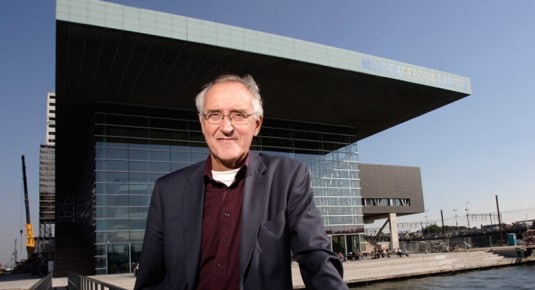Next weekend, from Friday 11 to Sunday 13 September, the Muziekgebouw aan 't IJ marked its tenth anniversary with a jam-packed festival three-day. From a cruise on the IJ with music by John Cage, a sleep concert by bassoonist Bram van Sambeek, a world premiere by Dutch Composer Willem Jeths, to a musical picnic in the entrance hall. No fewer than eight ensembles will perform on Friday to celebrate the 80th birthday of Arvo Pärt, grandmaster of the once so reviled but now lovingly embraced 'new spiritual music'. Rozalie Hirs signs for the music at an anniversary app of a walk around the Muziekgebouw. This is now known as the home of new music, but how did it even begin?
Wolffinarium
With three firm strokes on an immense gong, Queen Beatrix opened in 2005 the glass, stone and steel-framed dream of director Jan Wolff, who had lobbied for this for decades. His fight against a reluctant municipality of Amsterdam actually started when he founded the IJsbreker in 1980: this first hall in the world dedicated entirely to contemporary music suffered from the acoustics of a cardboard box. Initially the new building was therefore dubbed 'Wolffinarium', but success has many fathers, and after a few seasons Wolff was cast aside; in 2012 he died of a debilitating illness.

It initially took a storm. Tout cultural Netherlands wanted to see the spectacular design by Danes Nielsen, Nielsen and Nielsen with their own eyes. - And hear it, because Wolff had learned his lesson in terms of acoustics. To ensure that the new hall was also state of the art would be, he had hired the best specialists. They developed an ingenious system in which a moving ceiling can be used to lengthen or shorten the reverberation. This allows the sounds of both a small-scale chamber concert and a large vocal or instrumental ensemble to reach their full potential.
The renowned ensemble series 'Proms in Paradiso' moved with it, attracting twice as many visitors as before as 'Proms on the IJ'. There were teething problems too. These did not, by the way, concern the Bimhuis, protruding like a lifeboat to the side of the main building. This almost literal copy of the former venue on the Oude Schans managed to retain its cosy atmosphere from day one. Although the main building, with its immense staircase, looked impressive, visitors felt lost in the concrete emptiness of the foyer it opened into.
Waving Americans
It did not help that solid walls and ceilings between the various Foyerdecks were absent. Admittedly, visitors could enjoy an 'introduction with a view' - sometimes with the unintended bycatch of a cruise ship full of happily waving Americans - but this visual pleasure was severely disrupted as soon as a coffee cart was driven with deafening roar to the restaurant's kitchen a floor below. When winter arrived, the immense heights proved to absorb all the heat and fire cannons had to be rushed in to dispel the icy cold.
These imperfections led to a temporary dip in visitor numbers, but have since been remedied. Since pop temple Paradiso's artistic director Maarten van Boven took office in 2012, the Muziekgebouw again attracts full houses. Consequently, under his administration, the offerings have become much broader. Besides the Thursday evening concerts of avant-garde music, there are series around great pianists and vocalists, presenting the classical and romantic repertoire. These days, there is even room for early music.
A younger audience was reached with series such as Listen to this and The Rest is noise, which juxtaposes electronica, DJs and vjs with more mainstream composed music. There are also successful educational projects for the very young. In addition, festivals such as the Cello Biennale, Holland Festival, World Minimal Music Festival, the Flamenco Biennale and the Young Pianists Festival attract audiences of all shapes and ages. After ten years, the music temple stands like a house: it is a vibrant waterfront venue, a true place to be.
In short: reason to celebrate. The Muziekgebouw is packing big, with a very varied and almost lavish party weekend at which Jan Wolff would have licked his fingers. Too bad he can no longer be there.
